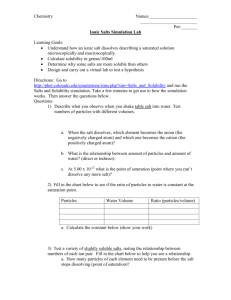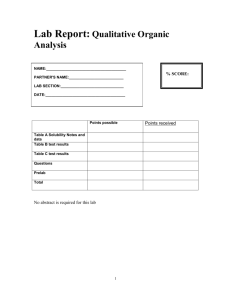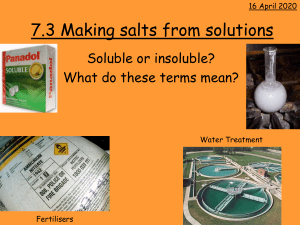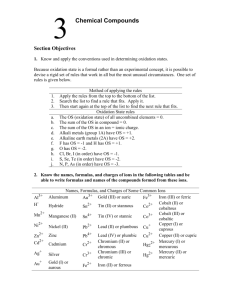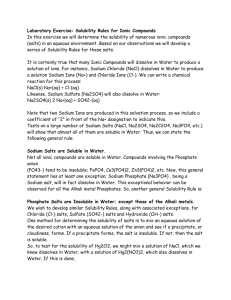2.5-Inorganic-Chemistry - Urban Moonshine Herb School
advertisement
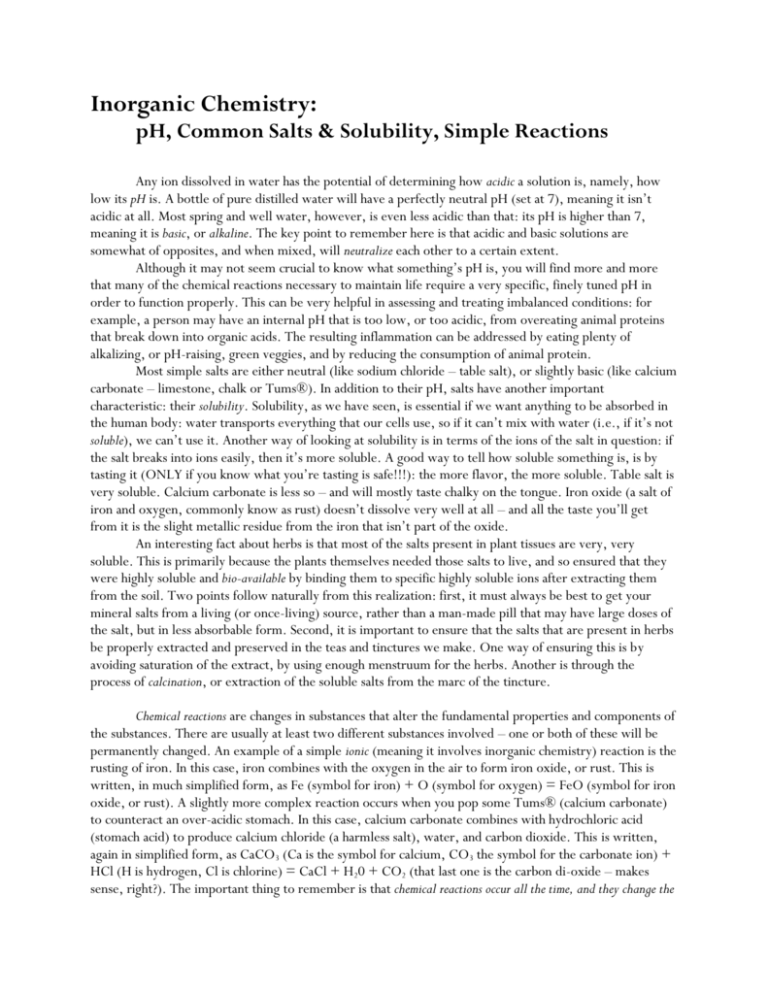
Inorganic Chemistry: pH, Common Salts & Solubility, Simple Reactions Any ion dissolved in water has the potential of determining how acidic a solution is, namely, how low its pH is. A bottle of pure distilled water will have a perfectly neutral pH (set at 7), meaning it isn’t acidic at all. Most spring and well water, however, is even less acidic than that: its pH is higher than 7, meaning it is basic, or alkaline. The key point to remember here is that acidic and basic solutions are somewhat of opposites, and when mixed, will neutralize each other to a certain extent. Although it may not seem crucial to know what something’s pH is, you will find more and more that many of the chemical reactions necessary to maintain life require a very specific, finely tuned pH in order to function properly. This can be very helpful in assessing and treating imbalanced conditions: for example, a person may have an internal pH that is too low, or too acidic, from overeating animal proteins that break down into organic acids. The resulting inflammation can be addressed by eating plenty of alkalizing, or pH-raising, green veggies, and by reducing the consumption of animal protein. Most simple salts are either neutral (like sodium chloride – table salt), or slightly basic (like calcium carbonate – limestone, chalk or Tums®). In addition to their pH, salts have another important characteristic: their solubility. Solubility, as we have seen, is essential if we want anything to be absorbed in the human body: water transports everything that our cells use, so if it can’t mix with water (i.e., if it’s not soluble), we can’t use it. Another way of looking at solubility is in terms of the ions of the salt in question: if the salt breaks into ions easily, then it’s more soluble. A good way to tell how soluble something is, is by tasting it (ONLY if you know what you’re tasting is safe!!!): the more flavor, the more soluble. Table salt is very soluble. Calcium carbonate is less so – and will mostly taste chalky on the tongue. Iron oxide (a salt of iron and oxygen, commonly know as rust) doesn’t dissolve very well at all – and all the taste you’ll get from it is the slight metallic residue from the iron that isn’t part of the oxide. An interesting fact about herbs is that most of the salts present in plant tissues are very, very soluble. This is primarily because the plants themselves needed those salts to live, and so ensured that they were highly soluble and bio-available by binding them to specific highly soluble ions after extracting them from the soil. Two points follow naturally from this realization: first, it must always be best to get your mineral salts from a living (or once-living) source, rather than a man-made pill that may have large doses of the salt, but in less absorbable form. Second, it is important to ensure that the salts that are present in herbs be properly extracted and preserved in the teas and tinctures we make. One way of ensuring this is by avoiding saturation of the extract, by using enough menstruum for the herbs. Another is through the process of calcination, or extraction of the soluble salts from the marc of the tincture. Chemical reactions are changes in substances that alter the fundamental properties and components of the substances. There are usually at least two different substances involved – one or both of these will be permanently changed. An example of a simple ionic (meaning it involves inorganic chemistry) reaction is the rusting of iron. In this case, iron combines with the oxygen in the air to form iron oxide, or rust. This is written, in much simplified form, as Fe (symbol for iron) + O (symbol for oxygen) = FeO (symbol for iron oxide, or rust). A slightly more complex reaction occurs when you pop some Tums® (calcium carbonate) to counteract an over-acidic stomach. In this case, calcium carbonate combines with hydrochloric acid (stomach acid) to produce calcium chloride (a harmless salt), water, and carbon dioxide. This is written, again in simplified form, as CaCO3 (Ca is the symbol for calcium, CO3 the symbol for the carbonate ion) + HCl (H is hydrogen, Cl is chlorine) = CaCl + H20 + CO2 (that last one is the carbon di-oxide – makes sense, right?). The important thing to remember is that chemical reactions occur all the time, and they change the actual substances that are involved. Physical changes, on the other hand, involve the same substance and are easily reversed: water turning to ice, for example, doesn’t become a different substance (it’s still water!), it just enters a different phase. In addition, ionic reactions involve the shuffling and recombining of ions in wholenumber proportions.
